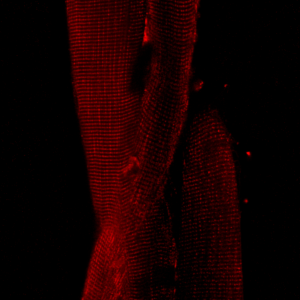Vendelin M, Béraud N, Guerrero K, Andrienko T, Kuznetsov AV, Olivares J, Kay L, Saks VA
Am. J. Physiol., Cell Physiol. 2005 Mar;288(3):C757-67
PMID: 15496480
Abstract

The aim of this work was to characterize quantitatively the arrangement of mitochondria in heart and skeletal muscles. We studied confocal images of mitochondria in nonfixed cardiomyocytes and fibers from soleus and white gastrocnemius muscles of adult rats. The arrangement of intermyofibrillar mitochondria was analyzed by estimating the densities of distribution of mitochondrial centers relative to each other (probability density function). In cardiomyocytes (1,820 mitochondrial centers marked), neighboring mitochondria are aligned along a rectangle, with distance between the centers equal to 1.97 +/- 0.43 and 1.43 +/- 0.43 microm in the longitudinal and transverse directions, respectively. In soleus (1,659 mitochondrial centers marked) and white gastrocnemius (621 pairs of mitochondria marked), mitochondria are mainly organized in pairs at the I-band level. Because of this organization, there are two distances characterizing mitochondrial distribution in the longitudinal direction in these muscles. The distance between mitochondrial centers in the longitudinal direction within the same I band is 0.91 +/- 0.11 and 0.61 +/- 0.07 microm in soleus and white gastrocnemius, respectively. The distance between mitochondrial centers in different I bands is approximately 3.7 and approximately 3.3 microm in soleus and gastrocnemius, respectively. In the transverse direction, the mitochondria are packed considerably closer to each other in soleus than in white gastrocnemius, with the distance equal to 0.75 +/- 0.22 microm in soleus and 1.09 +/- 0.41 microm in gastrocnemius. Our results show that intermyofibrillar mitochondria are arranged in a highly ordered crystal-like pattern in a muscle-specific manner with relatively small deviation in the distances between neighboring mitochondria. This is consistent with the concept of the unitary nature of the organization of the muscle energy metabolism.